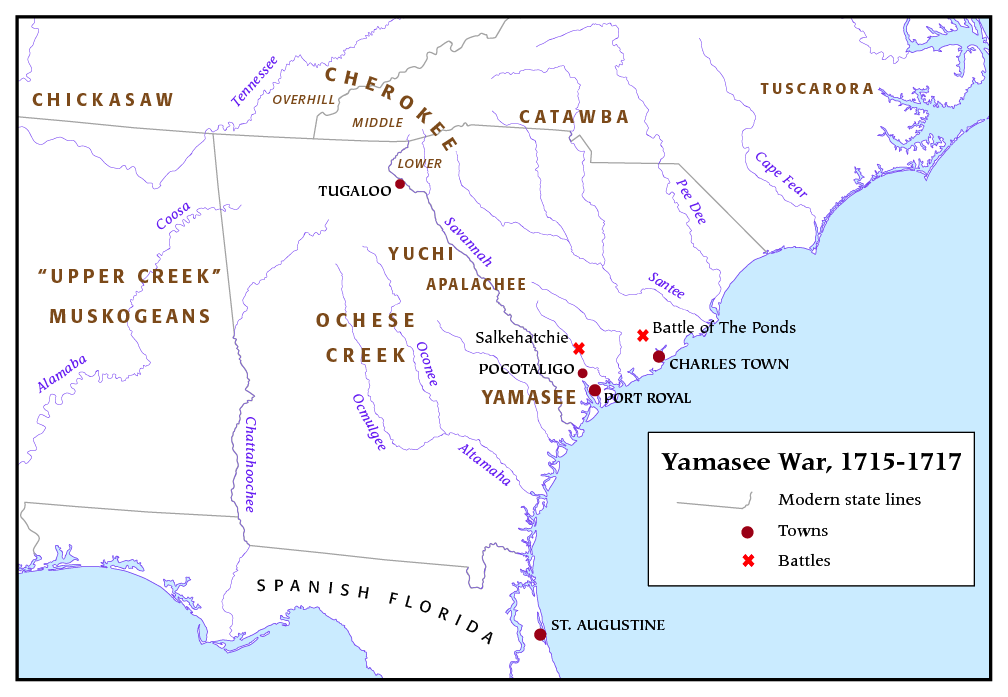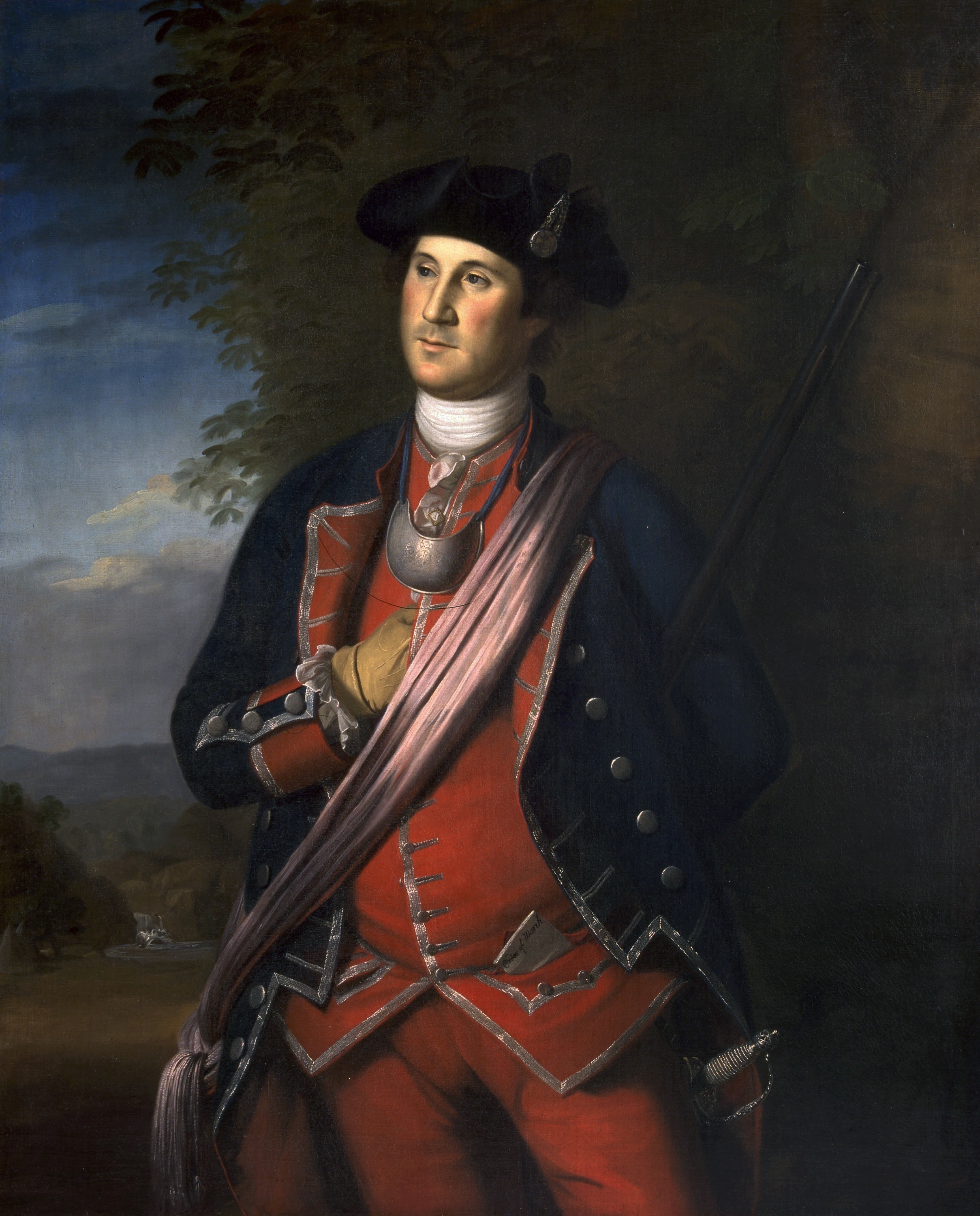|
Yamasee War
The Yamasee War (also spelled Yamassee or Yemassee) was a conflict fought in South Carolina from 1715 to 1717 between British settlers from the Province of Carolina and the Yamasee and a number of other allied Native American peoples, including the Muscogee, Cherokee, Catawba, Apalachee, Apalachicola, Yuchi, Savannah River Shawnee, Congaree, Waxhaw, Pee Dee, Cape Fear, Cheraw, and others. Some of the Native American groups played a minor role, while others launched attacks throughout South Carolina in an attempt to destroy the colony. Native Americans killed hundreds of colonists and destroyed many settlements, and they killed traders throughout the southeastern region. Colonists abandoned the frontiers and fled to Charles Town, where starvation set in as supplies ran low. The survival of the South Carolina colony was in question during 1715. The tide turned in early 1716 when the Cherokee sided with the colonists against the Creek, their traditional enemy. The la ... [...More Info...] [...Related Items...] OR: [Wikipedia] [Google] [Baidu] |
American Indian Wars
The American Indian Wars, also known as the American Frontier Wars, and the Indian Wars, were fought by European governments and colonists in North America, and later by the United States and Canadian governments and American and Canadian settlers, against various American Indian and First Nation tribes. These conflicts occurred in North America from the time of the earliest colonial settlements in the 17th century until the early 20th century. The various wars resulted from a wide variety of factors, the most common being the desire of settlers and governments for lands that the Indian tribes considered their own. The European powers and their colonies also enlisted allied Indian tribes to help them conduct warfare against each other's colonial settlements. After the American Revolution, many conflicts were local to specific states or regions and frequently involved disputes over land use; some entailed cycles of violent reprisal. As settlers spread westward across North America ... [...More Info...] [...Related Items...] OR: [Wikipedia] [Google] [Baidu] |
Waxhaw People
The Waxhaw people (also referred to as Wisacky, the Gueça and possibly Wastana and Weesock) were a tribe native to what are now the counties of Lancaster, in South Carolina; and Union and Mecklenburg in North Carolina, around the area of present-day Charlotte. The Waxhaw were related to other nearby Southeastern peoples, such as the Catawba people and the Sugeree. It is speculated that they were culturally influenced by the Mississippian culture. Some scholars suggest the Waxhaw may have been a band of the Catawba rather than a distinctly separate people, given the similarity in what is known of their language and customs. A distinctive custom which they shared was flattening the forehead of individuals as infants; the only other people group to do so in the southeastern United States is the Choctaw. Flattening of the head gave the Waxhaw a distinctive look, with wide eyes and sloping foreheads. They started the process at birth by binding the infant to a flat board. The wide ... [...More Info...] [...Related Items...] OR: [Wikipedia] [Google] [Baidu] |
Iroquoian Languages
The Iroquoian languages are a language family of indigenous peoples of North America. They are known for their general lack of labial consonants. The Iroquoian languages are polysynthetic and head-marking. As of 2020, all surviving Iroquoian languages are severely or critically endangered, with only a few elderly speakers remaining. The two languages with the most speakers, Mohawk in New York and Cherokee, are spoken by less than 10% of the populations of their tribes. Family division :Northern Iroquoian ::Lake Iroquoian :::Iroquois Proper ::::Seneca (severely endangered) :::: Cayuga (severely endangered) ::::Onondaga (severely endangered) :::: Susquehannock/Conestoga (*) ::::Mohawk–Oneida ::::: Oneida (severely endangered) :::::Mohawk :::Huronian (†) :::: Huron-Wyandot (*) :::: Petun (Tobacco) (*) :::Tuscarora–Nottoway (*) ::::Tuscarora *) :::: Nottoway (*) :::Unclear :::: Wenrohronon/Wenro (*) ::::Neutral (*) ::::Erie (*) :::: Laurentian (*) :Southern Iroquoian: ::::Che ... [...More Info...] [...Related Items...] OR: [Wikipedia] [Google] [Baidu] |
Tuscarora People
The Tuscarora (in Tuscarora ''Skarù:ręˀ'', "hemp gatherers" or "Shirt-Wearing People") are a Native American tribe and First Nations band government of the Iroquoian family, with members today in New York, USA, and Ontario, Canada. They coalesced as a people around the Great Lakes, likely about the same time as the rise of the Five Nations of the historic Iroquois Confederacy, also Iroquoian-speaking and based then in present-day New York. Well before the arrival of Europeans in North America, the Tuscarora had migrated south and settled in the region now known as Eastern Carolina. The most numerous Indigenous people in the area, they lived along the Roanoke, Neuse, Tar (''Torhunta'' or ''Narhontes''), and Pamlico rivers.F.W. Hodge, "Tuscarora" ''Handbook of American Indians'', ... [...More Info...] [...Related Items...] OR: [Wikipedia] [Google] [Baidu] |
Tuscarora War
The Tuscarora War was fought in North Carolina from September 10, 1711 until February 11, 1715 between the Tuscarora people and their allies on one side and European American settlers, the Yamassee, and other allies on the other. This was considered the bloodiest colonial war in North Carolina. The Tuscarora signed a treaty with colonial officials in 1718 and settled on a reserved tract of land in Bertie County, North Carolina. The war incited further conflict on the part of the Tuscarora and led to changes in the slave trade of North and South Carolina. The first successful settlement of North Carolina began in 1653. The Tuscarora lived in peace with the settlers for more than 50 years, while nearly every other colony in America was involved in some conflict with Native Americans. Most of the Tuscarora migrated north to New York after the war, where they joined the Five Nations of the Iroquois Confederacy as the sixth nation. History The Tuscarora were an Iroquoian-speaking ... [...More Info...] [...Related Items...] OR: [Wikipedia] [Google] [Baidu] |
Spanish Florida
Spanish Florida ( es, La Florida) was the first major European land claim and attempted settlement in North America during the European Age of Discovery. ''La Florida'' formed part of the Captaincy General of Cuba, the Viceroyalty of New Spain, and the Spanish Empire during Spanish colonization of the Americas. While its boundaries were never clearly or formally defined, the territory was initially much larger than the present-day state of Florida, extending over much of what is now the southeastern United States, including all of present-day Florida plus portions of Georgia, Alabama, Mississippi, North Carolina, South Carolina, and Louisiana. Spain's claim to this vast area was based on several wide-ranging expeditions mounted during the 16th century. A number of missions, settlements, and small forts existed in the 16th and to a lesser extent in the 17th century; they were eventually abandoned due to pressure from the expanding English and French colonial settlements, the collap ... [...More Info...] [...Related Items...] OR: [Wikipedia] [Google] [Baidu] |
Louisiana (New France)
Louisiana (french: La Louisiane; ''La Louisiane Française'') or French Louisiana was an administrative district of New France. Under French control from 1682 to 1769 and 1801 (nominally) to 1803, the area was named in honor of King Louis XIV, by French explorer René-Robert Cavelier, Sieur de la Salle. It originally covered an expansive territory that included most of the drainage basin of the Mississippi River and stretched from the Great Lakes to the Gulf of Mexico and from the Appalachian Mountains to the Rocky Mountains. Louisiana included two regions, now known as Upper Louisiana (), which began north of the Arkansas River, and ''Lower Louisiana'' (). The U.S. state of Louisiana is named for the historical region, although it is only a small part of the vast lands claimed by France.La Louisiane française 1682-1803 ... [...More Info...] [...Related Items...] OR: [Wikipedia] [Google] [Baidu] |
Indian Slave Trade
Slavery among Native Americans in the United States includes slavery by and slavery of Native Americans roughly within what is currently the United States of America. Tribal territories and the slave trade ranged over present-day borders. Some Native American tribes held war captives as slaves prior to and during European colonization. Some Native Americans were captured and sold by others into slavery to Europeans, while others were captured and sold by Europeans themselves. In the late 18th and 19th centuries, a small number of tribes, such as the five so-called "civilized tribes", began increasing their holding of African-American slaves.Smith, Ryan P. 6 March 2018.How Native American Slaveholders Complicate the Trail of Tears Narrative" ''Smithsonian Magazine''. European contact greatly influenced slavery as it existed among pre-contact Native Americans, particularly in scale. As they raided other tribes to capture slaves for sales to Europeans, they fell into destruct ... [...More Info...] [...Related Items...] OR: [Wikipedia] [Google] [Baidu] |
Muscogee Creek
The Muscogee, also known as the Mvskoke, Muscogee Creek, and the Muscogee Creek Confederacy ( in the Muscogee language), are a group of related indigenous (Native American) peoples of the Southeastern WoodlandsTranscribed documents Sequoyah Research Center and the American Native Press Archives in the . Their original homelands are in what now comprises southern , much of , western |
Colonial American Military History
Colonial American military history is the military record of the Thirteen Colonies from their founding to the American Revolution in 1775. Beginning when on August 29, 1643, the Plymouth Colony Court allowed & established a military discipline to be erected and maintained. Rangers Rangers in North America served in the 17th and 18th-century wars between colonists and Native American tribes. Regular soldiers were not accustomed to frontier warfare and so Ranger companies were developed. Rangers were full-time soldiers employed by colonial governments to patrol between fixed frontier fortifications in reconnaissance, providing early warning of raids. In offensive operations, they were scouts and guides, locating villages and other targets for task forces drawn from the militia or other colonial troops. The father of American ranging is Colonel Benjamin Church (c. 1639–1718).John Grenier. The First Way of War: American War Making on the Frontier. Cambridge University Press. 200 ... [...More Info...] [...Related Items...] OR: [Wikipedia] [Google] [Baidu] |
Charleston, South Carolina
Charleston is the largest city in the U.S. state of South Carolina, the county seat of Charleston County, and the principal city in the Charleston–North Charleston metropolitan area. The city lies just south of the geographical midpoint of South Carolina's coastline on Charleston Harbor, an inlet of the Atlantic Ocean formed by the confluence of the Ashley, Cooper, and Wando rivers. Charleston had a population of 150,277 at the 2020 census. The 2020 population of the Charleston metropolitan area, comprising Berkeley, Charleston, and Dorchester counties, was 799,636 residents, the third-largest in the state and the 74th-largest metropolitan statistical area in the United States. Charleston was founded in 1670 as Charles Town, honoring King CharlesII, at Albemarle Point on the west bank of the Ashley River (now Charles Towne Landing) but relocated in 1680 to its present site, which became the fifth-largest city in North America within ten years. It remained unincorpor ... [...More Info...] [...Related Items...] OR: [Wikipedia] [Google] [Baidu] |







